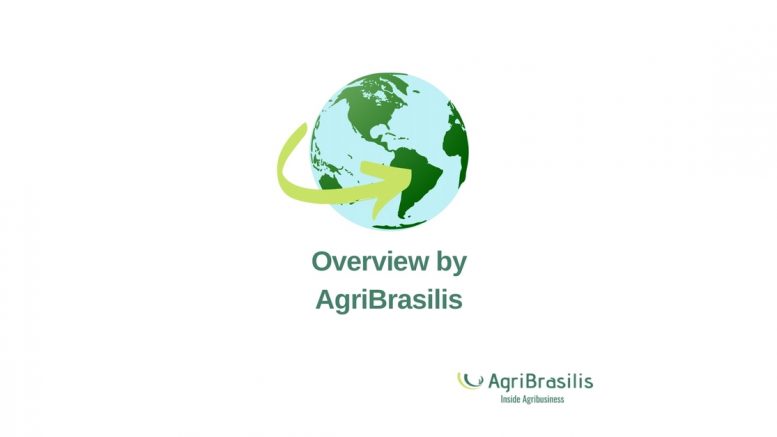Centro de Tecnologia Canavieira should launch three new varieties of sugarcane in 2023
Rosario Grain Exchange estimates that the 2022/23 harvest should record the lowest wheat exports in eight years because of severe drought. Wheat exports are expected to reach just 6.5 million tonnes, that represents a 35% drop when compared to the 10 million tonnes forecast in October. (Rosario Grain Exchange; USDA)
Government is seeking funding for irrigation projects in the midst of drought that hits the main agricultural centers in Buenos Aires, Córdoba and Santa Fé. For this, it is necessary to face the macroeconomic problems that affect the country. “It is clear that the macroeconomic conditions are not what we would like. We are working hard so that, in 90 days, we can improve at the macroeconomic level to give confidence to the market”, said the secretary of agriculture, Juan José Bahillo. At the end of October, planted areas suffering from severe drought reached almost 23 million hectares, above the almost 7.2 million hectares recorded in September. (Ministry of Agriculture)
![]()
Arara Seed, a platform for collective investment in agribusiness startups created in June 2022 in Ribeirão Preto, State of São Paulo, announced that it expects to promote US$ 1.13 million in transactions by the end of 2023. (Arara Seed)
Brazilian Association of Animal Protein recommends the immediate suspension of visits to farms, slaughterhouses and other poultry establishments, both for Brazilians and foreigners. Only those who work directly and exclusively in each production facility should have authorized access. Recommendation is valid regardless of the fulfillment of measures previously adopted to authorize access, in which the professional from another country complied with a quarantine period to attest to the absence of contamination. Measures aim to prevent the entry and dissemination of avian influenza in Brazil. (ABPA)
MAPA intercepts 49 tonnes of contaminated raisins at the border in São Borja, State of Rio Grande do Sul, and Foz do Iguaçu, State of Paraná. Products were destined for the manufacturing of panettones and for direct sale to the final consumer. Cargo was contaminated with four times the permitted level of Ochratoxin A, a substance produced by fungi. “By exceeding the allowed mycotoxin limit, the product becomes toxic”, explains Plant Quality Inspection coordinator, Tiago Dokonal. (Ministry of Agriculture)
Centro de Tecnologia Canavieira should launch three new varieties of sugarcane in 2023, two of which are aimed at restrictive environments, where the market has a greater need for varieties. “New varieties must exceed a productivity scale established by the main options on the market, in addition to being disease-free. Expectation with the launches of the CTC9008, CTC3445 and CTC9009 is to establish a new level of productivity in relation to the materials currently available,” explains Luiz Paes, CTC’s commercial director. Variety CTC9008 has high productivity and high tillering, characteristics that favor the longevity of the sugarcane farm. CTC3445, on the other hand, is extremely sturdy and has important agronomic characteristics for handling during the middle and end of the harvest. Variety CTC9009 has a high sugar content as its main characteristic. (CTC)

![]()
Exports of walnuts and almonds to Brazil have reached more than US$ 18 million in 2022. Brazil is the 8th main destination market for Chilean walnuts, with sales reaching more than US$ 14 million, that represents an increase of 3.5% compared to the first 10 months of 2021. Turkey is the main destination for walnuts, reaching US$ 80 million, that represents a growth of 63%. Chile is the world’s third largest exporter of walnuts. (ProChile)
Chilean Institute of Agricultural Research launched a new variety of wheat, called Monarka INIA, a winter variety developed by the Institute’s Wheat Genetic Improvement Program in the Araucanía Region, with high yield and good quality characteristics for bread manufacturing. Wheat is considered a key crop for Chile in terms of volume, area and economic value, with more than 85% of its production concentrated in the center-southern region of the country. (INIA)

Colombian Agricultural Research Corporation developed a program to obtain banana plants that are more resistant to Fusarium sp., based on the introduction of improved materials from different breeding programs around the world. Genetic improvement in bananas is limited by high levels of plant sterility, that make it difficult to obtain seeds. For this reason, genetic improvement programs for banana plants use biotechnological strategies that allow the rescue of embryos produced in breeding programs. (Agrosavia)

Four cities in the state of Sonora were declared part of the region under protection against quarantine potato pests. Senasica verified the absence of three of the main potato pests in the cities of Altar, Caborca, Pitiquito and Trincheiras. Measure establishes regulation of the entry of potato seed tubers to reduce the risk of introducing Clavibacter michiganensis, Ralstonia solanacearum race 3 and Leptinotarsa decemlineata, that can cause serious damage to agricultural production. (National Health, Safety and Food Quality Service)


Banana production faces a crisis. Low product quality makes it difficult to export to more restrictive markets. Oversupply and price devaluation aggravated the lack of consumer market. New difficulties on the export to Argentina, that purchases 70% of national production, are also a factor. Argentina adopted a rule that establishes that payment for shipments must be made only after 120 days. Banana farmers blocked access to the city of Tembiaporã in the department of Caaguazú, in protest against low prices. Payment received by farmers is much lower than international prices. Farmers are also urgently requesting the National Development Bank to speed up the implementation of new credit tools. (BNF; Paraguayan Chamber of Banana and Pineapple)
![]()
Approximately 30% of Hass avocado production in the high Andes is at risk because of drought. “There’s a risk that if the fruit doesn’t get enough water, it will get small. I wouldn’t be able to say what the dimension or size of the problem is, but there is this risk, especially in the Andean areas”, points out Juan Carlos Paredes, president of Prohass. (Prohass)
Rice, potatoes, corn and quinoa are the crops most affected by the drought. Farmers demand government attention in face of the water crisis. According to experts, this is one of the worst droughts in the past 10 years, mainly because of the La Niña phenomenon, that persists in the region for the third consecutive year. (Ministry of Agriculture)
According to the representative of the Association of Organic Products of Peru, Eusebio Vásquez, the prolonged drought, lack of fertilizers, increased cost of inputs and labor prices are factors that should cause a 30% to 40% decrease in agricultural production. Vásquez asks that the government declares a state of agricultural emergency for the regions most affected by the lack of rain. (ANPE)

MORE ABOUT AGRIBUSINESS:

